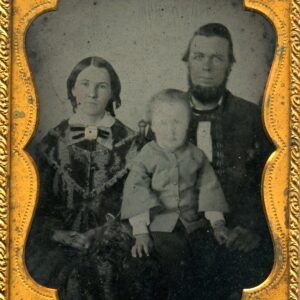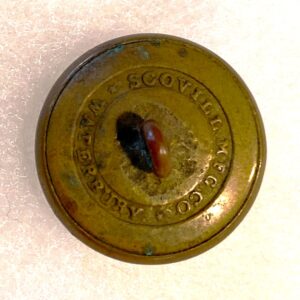Description
This pair of sixth plate tintypes are the only cased images I have ever seen of Civil War ironclads. The images were found together in a very nice thermoplastic case. They are matted and framed with identical mats and preservers. The images are somewhat dark, but show very well. The content is exceptional. The images were published in the Summer 2019 issue of Military Images Magazine in Ron Field’s article, “A Tale of Two Steamers.” The first image includes a row of steamboats docked along a shoreline, with the Edward Walsh moored at the far end of the row. An unidentified gunboat and an Eads ironclad lie just off shore. Several laden wagons approach the camera. The Edward Walsh saw both Confederate and Union service, transporting both troops and gunpowder on the Mississippi River. The second image includes the docked steamboat Hamilton Belle and a US dispatch boat in the middle distance. Further offshore is a complete view of an Eads ironclad. The Hamilton Belle transported troops and munitions along the Mississippi River for the Union, including sick soldiers. She was subject to guerrilla activity, and was used to sweep waterways for obstructions. At one point she was found to be smuggling medical supplies. Several dispatch boats operated on Western rivers, and the paddle box on this one is clearly painted with the words “USN DESPATCH.” Reversed views of each image, as shown in the MI article, are included so that the vessel names are easier to read. A short history of the Eads City-Class ironclads is provided below:
James B. Eads was a well-known man along the Mississippi River when Fort Sumter fell in April 1861. Eads had become very wealthy by salvaging wrecked boats on the western rivers, and he believed that taking control of the lower Mississippi from the new Confederacy by building a fleet of gunboats would be vital to restoring the Union. On April 29, 1861 he was given the opportunity to present his ideas to the Navy Department, where he was introduced to the Secretary of the Navy, the Hon. Gideon Welles, and to Captain G. V. Fox, afterward Assistant Secretary. Eads’ recommendation of utilizing an inland navy to recover the lower Mississippi, thus blocking a major supply line of the South, was given serious consideration by Secretary Welles. Naval constructor Samuel M. Pook was brought in to study the idea. After much consultation, evaluation and review, Pook recommended a vessel design. Advertisements inviting bids were published in July 1861, and Eads’ bid was accepted in August 1861. Eads was to construct 7 gun-boats, which, according to the contract, were to draw 6 feet of water, carry 13 heavy guns each, be plated with 2 ½-inch iron, and have a speed of 9 miles per hour. The De Kalb (at first called the St. Louis) was the type of the other six, named the Carondelet, Cincinnati, Louisville, Mound City, Cairo, and Pittsburgh. They were 175 feet long, 51 ½ feet beam; the flat sides sloped at an angle of about thirty-five degrees, and the front and rear casemates corresponded with the sides, the stern-wheel being entirely covered by the rear casemate. Each was pierced for three bow guns, eight broadside guns (four to a side), and two stern guns.” The St. Louis was in commission by the end of the year, and the other six were commissioned in January 1862. The city-class gunboats were known by the less than glamourous name “Pook Turtles.” Captain Andrew H. Foote was in charge of the flotilla.
The first use of the gunboats was in the battle of Fort Henry on February 6, 1862, a victory for the Union. They participated in most of the actions along the upper Mississippi and its tributaries. Key operations included Fort Donelson, Island Number 10, Fort Pillow, Plum Point, Memphis, Vicksburg and the Red River Campaign. At the battle of Plum Point, the Cincinnati and Mound City were rammed and sank in shallow water. Both vessels were refloated and repaired. On December 12, 1862, while operating on the Yazoo River, the Cairo hit two torpedoes and sank. She was recovered in the early 1960s and is displayed at the Vicksburg National Military Park. The Baron De Kalb (formerly St. Louis) was sunk in the Yazoo River on July 13, 1863. The surviving gunboats were sold for scrap after the war.
I cannot emphasize enough the rarity of these two images. I have never seen another hard image of a Civil War ironclad, and I doubt that I ever will. Making the images even better is the identified steamboats with their own interesting histories, and the view of the USN dispatch vessel (a rarity in its own right). If you are a serious collector of Naval images, you will never have another opportunity like this.











